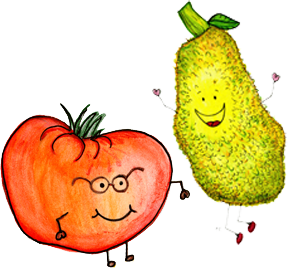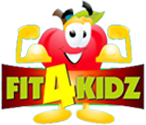Learning Corner
Lesson Plans
Hi Kids, We have some exciting information for you to learn more about nutrition and how food can help you grow. The key to staying healthy is to feed your body the right kinds of nutritious foods that will keep you growing and feeling strong. Here are some fun lessons and activities to help you learn more about nutrition and which foods are best to keep your body fueled all day long!
These presentations, lesson plans and activities can help kids make healthier food choices and maintain a healthy weight and an active lifestyle. They can be used in group settings in schools, clubs or training sessions and include take home activities for kids and information for parents to help create nutritious meals and healthy lifestyles!
There are different lesson plans, activities and presentations for kindergarten to 2nd grade and for 3rd to 5th grade, so go ahead and get started! .

Program Introduction: Food Groups & MyPlate
In this first lesson, we will start with the basics – an overview of the food groups and how to create a balanced diet using these groups as guidelines.
Healthy Weight and a Balanced Breakfast
Introduce students to the importance of healthy eating and physical activity to maintain a healthy weight and convey the significance of starting the day with breakfast.
Track Your Food Intake
Introduce children to Food Frequency Questionnaires (FFQ) and explain how they can use a FFQ to assess their dietary intake patterns.
Carbohydrates & Grains
Introduce children to the importance of grains as the base of a healthy, balanced diet and help them distinguish between the different types of carbohydrates.
Full of Fiber
Introduce children to the importance of fiber-rich foods in their daily lives to maintain a balanced and healthy diet.
The Power of Protein: Meats and Beans
Introduce students to the importance of getting adequate protein and to teach them to identify foods that are good sources of protein
Dairy, Calcium and Vitamin D
Introduce students to the importance of getting adequate protein and to teach them to identify foods that are good sources of protein
Lipid and Fats: All about Oils
Discuss with students the importance of getting a small amount of healthy fats in their diet and how to avoid foods high in saturated and trans-fat.
Vegetables: Vivacious Veggies
To introduce students to a variety of vegetables and teach them the importance of eating a “rainbow” of different vegetables each week.
Fruits: Fun Facts
To introduce students to a variety of fruits and teach them the importance of eating a “rainbow” of different fruits each week.
Beverages: Water, Sodas & Juice
Introduce children to the importance of drinking plenty of water and limiting intake of high-calorie drinks, such as sodas and juices.
Serving Size & Portion Control
To help students understand what different portion sizes look like and how to apply this knowledge to meals in order to maintain a healthy, balanced diet.
Nutrients the Body Needs
Introduce students to the importance of eating vitamins and minerals to keep their bodies healthy.
Food Label Fun
In this lesson, we will teach students how to read and understand food labels to help them make healthier food choices.
Exercise: E is for Exercise
Introduce students to the importance of physical activity for a healthy mind and body. Explain that bad habits formed at childhood can cause adverse effects later in life.
Healthy School Lunches
To help students learn about the components of a healthy school lunch and how to use this knowledge to help to prepare and/or buy a lunch.
Healthy Snacks and Easy Recipes
In this first lesson, we will start with the basics – an overview of the food groups and how to create a balanced diet using these groups as guidelines.
Grocery Shopping for Kids
Introduce children to the general layout of a supermarket and help them strengthen their shopping skills in order to choose nutritious and safe foods.
Alternative Diets
To teach students about alternative diets that accommodate various dietary needs and beliefs, such as vegetarian/vegan, gluten-free and lactose-free diets.
Review, Quiz & Graduation Ceremony
Review the material students learned through the Fit4Kidz program and congratulate them on completing the program by distributing graduation certificates.
Program Introduction: MyPlate & Food Groups
In this first lesson, we will start with the basics – an overview of the food groups and how to create a balanced diet using these groups as guidelines.
Healthy Weight and a Balanced Breakfast
Introduce students to the importance of healthy eating and physical activity to maintain a healthy weight and convey the significance of starting the day with breakfast.
Track Your Food Intake
Introduce children to Food Frequency Questionnaires (FFQ) and explain how they can use a FFQ to assess their dietary intake patterns.
Carbohydrates & Grains
Introduce children to the importance of grains as the base of a healthy, balanced diet and help them distinguish between the different types of carbohydrates.
Full of Fiber
Introduce children to the importance of fiber-rich foods in their daily lives to maintain a balanced and healthy diet.
The Power of Protein: Meats and Beans
Introduce students to the importance of getting adequate protein and to teach them to identify foods that are good sources of protein
Dairy, Calcium and Vitamin D
Introduce students to the importance of getting adequate protein and to teach them to identify foods that are good sources of protein
Lipid and Fats: All about Oils
Discuss with students the importance of getting a small amount of healthy fats in their diet and how to avoid foods high in saturated and trans-fat.
Vegetables: Vivacious Veggies
To introduce students to a variety of vegetables and teach them the importance of eating a “rainbow” of different vegetables each week.
Fruits: Fun Facts
To introduce students to a variety of fruits and teach them the importance of eating a “rainbow” of different fruits each week.
Beverages: Water, Sodas & Juice
Introduce children to the importance of drinking plenty of water and limiting intake of high-calorie dinks, such as sodas and juices.
Serving Size & Portion Control
To help students understand what different portion sizes look like and how to apply this knowledge to meals in order to maintain a healthy, balanced diet.
Nutrients the Body Needs
Introduce students to the importance of eating vitamins and minerals to keep their bodies healthy.
Food Label Fun
In this first lesson, we will start with the basics – an overview of the food groups and how to create a balanced diet using these groups as guidelines.
Exercise: E is for Exercise
Introduce students to the importance of physical activity for a healthy mind and body. Explain that bad habits formed at childhood can cause adverse effects later in life.
Healthy School Lunches
To help students learn about the components of a healthy school lunch and how to use this knowledge to help to prepare and/or buy a lunch.
Healthy Snacks and Easy Recipes
In this first lesson, we will start with the basics – an overview of the food groups and how to create a balanced diet using these groups as guidelines.
Grocery Shopping for Kids
Introduce children to the general layout of a supermarket and help them strengthen their shopping skills in order to choose nutritious and safe foods.
Alternative Diets
To teach students about alternative diets that accommodate various dietary needs and beliefs, such as vegetarian/vegan, gluten-free and lactose-free diets.
Review, Quiz & Graduation Ceremony
Review the material students learned through the Fit4Kidz program and congratulate them on completing the program by distributing graduation certificates.
